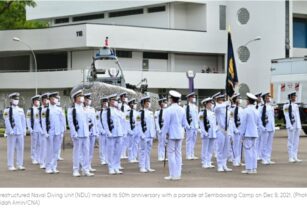IN FOCUS: The inside story of how ISD crippled a terrorist network targeting Singapore after 9/11
 December 04, 2021
December 04, 2021
Twenty years ago, the Internal Security Department uncovered a plot to launch terror attacks against Singapore. CNA looks back at how it raced against time to thwart what would have brought devastating consequences for the country.
SINGAPORE: As the World Trade Center towers in New York came crashing down on Sep 11, 2001, officers of Singapore’s Internal Security Department (ISD) watched in horror.
Al-Qaeda and its leader Osama Bin Laden had claimed responsibility for the terrorist attack, and security agencies around the world scrambled to make sense of the implications for their countries.
“As a security agency, we were also taken by surprise, but at the same time, we also wanted to make sure that there is no imminent threat to Singapore, and that there is no Singaporean who is a part of this,” Rajah*, a senior operations officer with ISD, told CNA’s Insight programme.
In 2001, Rajah headed a team of operations officers that dismantled the Jemaah Islamiyah (JI) terrorist network in Singapore after uncovering multiple plots against targets here.
The scale, audacity and intricacy of these plots – using explosives to attack US military personnel, bases and foreign embassies in Singapore – shocked ISD officers at the time.
Twenty years on, these well-developed plots remain Singapore’s closest shave with transnational Islamist terrorism to date, ISD said in a news release on Saturday (Dec 4).
The JI operatives in Singapore had been trained by terrorists in Afghanistan and the southern Philippines, and had received instructions and support from foreign Al-Qaeda operatives. This meant they had the skills and technical know-how to wreak havoc in Singapore.
“Had the group succeeded in their plans, there would have been catastrophic consequences, both in terms of physical loss of lives and damage to Singapore’s communal harmony and social fabric,” ISD said.
But in the aftermath of the 9/11 attack, Rajah, now in his mid-50s, said ISD was not aware of JI’s existence. The department reached out to the community, eager to address concerns, urge vigilance and appeal for any information that might connect Singaporeans to the attack.
THE TIP-OFF
It was during one of these community engagements, days after the 9/11 attack, that the department was tipped off.
This set the wheels in motion for an operation, between December 2001 and August 2002, that would lead to 56 people being detained under the Internal Security Act.
The tip off came from a “vigilant” Singaporean who had information on Mohammad Aslam Yar Ali Khan, ISD said. According to the informant, Aslam, a Singaporean of Pakistani descent, claimed to know Osama Bin Laden and said he had fought against the Soviets in Afghanistan.
“That set some alarm bells ringing in us, especially against the backdrop of 9/11. So, we were very concerned,” Rajah said.
 Detailed sketches and notes of Yishun MRT and its vicinity found in Afghanistan. (Photo: Internal Security Department)
Detailed sketches and notes of Yishun MRT and its vicinity found in Afghanistan. (Photo: Internal Security Department)
 Detailed sketches and notes of Yishun MRT and its vicinity found in Afghanistan. (Photo: Internal Security Department)
Detailed sketches and notes of Yishun MRT and its vicinity found in Afghanistan. (Photo: Internal Security Department)
 Detailed sketches and notes of Yishun MRT and its vicinity found in Afghanistan. (Photo: Internal Security Department)
Detailed sketches and notes of Yishun MRT and its vicinity found in Afghanistan. (Photo: Internal Security Department)
 Detailed sketches and notes of Yishun MRT and its vicinity found in Afghanistan. (Photo: Internal Security Department)
Detailed sketches and notes of Yishun MRT and its vicinity found in Afghanistan. (Photo: Internal Security Department)
ISD officers started to watch Aslam and his associates very closely.
On Oct 4, 2001, Aslam left Singapore on a flight to Pakistan, en route to Afghanistan. In the middle of that month, officers observed that Aslam’s close friend was in close contact with foreign terrorist elements and actively tried to buy ammonium nitrate, an explosive material.
The friend had also converted US dollars into local currency, later discovered to be payment for the reconnaissance of the US and Israeli embassies and other locations in Singapore as part of plans for an imminent attack.
“(This was) information that we put together and we were in the process of working out, mapping out the network of Aslam and associates, and how we want to execute our operation,” Rajah said.

Former JI member Jameel* joined the group in 1989 before he was trained in Afghanistan and tasked to plan sabotage operations against US interests in Singapore.
The former JI members CNA interviewed for this story have been rehabilitated and released from detention.
JI had also planned to impair Singapore’s military capabilities by targeting the Ministry of Defence (MINDEF) headquarters in Bukit Gombak, ISD said. So, Jameel was asked to conduct reconnaissance of Gombak camp.
That year, the cell surveyed the perimeter and exits of the camp, and even entered the compound on several occasions under the guise of courier services, ISD said.
 Report from a reconnaissance mission on MINDEF headquarters. (Photo: Internal Security Department)
Report from a reconnaissance mission on MINDEF headquarters. (Photo: Internal Security Department)
“As a leader of the cell, I sent one of my men to become a dispatch rider where he went into MINDEF to deliver parcels or packages,” Jameel, now in his late 50s and working as a cleaner, told CNA.
“In the mail room, he surveyed what was in the mail room, then he came out and looked around the MINDEF compound.”
One of the cell members also worked at a company that distributed a defence magazine whose subscribers included officers who worked at Gombak. “So we got to know some names, and we gave these to our seniors,” Jameel said.
One of the more detailed schemes was when a JI member tailed a MINDEF officer from Gombak all the way to Tampines. It turned out that JI had considered placing explosives in a MINDEF officer’s car and detonating them while the car was in the camp, ISD said.
CHANGE OF PLANS
Then on Dec 3, the media published a report that Aslam had been arrested by the Northern Alliance in Afghanistan.
The story, which was likely to attract further media attention, forced ISD’s hand. The department decided to bring forward its operation against Aslam’s associates before they went underground or left the country to escape arrest.
On Dec 8, the operation began. ISD senior research officer Wei Ling* remembers vividly how that day, a Saturday, started.
“When my research team, colleagues and I went into the office that day, we thought that it was pretty much going to be an open-and-shut kind of operation that would be wrapped up by that weekend, or just a few days after that,” she told CNA.
“But by nightfall on Saturday, we realised that we were so far wrong, and that we had actually stumbled on something big. Specifically, we had to somehow race against the clock to stop terrorist attacks from happening on Singapore’s soil.”
The next day, ISD officers arrested six of Aslam’s associates and seized items of interest from their homes.
PEELING BACK THE LAYERS
Back at the office, the pressure was mounting.
Research officers like Wei Ling worked 12-hour shifts, each handling two or three suspects that had been brought in. These officers worked directly with their operations counterparts, who were assigned the same suspects to focus on.
Wei Ling, now in her 40s, said it was tough work in the beginning because the JI suspects were not talking: “They were clamming up, which basically meant that we do not know what to look out for,” she said.
“So, it really felt like we were trying to put together a 10,000-piece jigsaw puzzle but the problem is that we did not know how it was supposed to look like in the end.”
The plan was for ISD’s operations officers to try breaking down the suspects, Wei Ling said, while research officers combed through the copious amounts of evidence that had been seized.
These included things like photo albums, religious books, name cards and even scraps of paper stuck between the pages of books.
The discoveries got more sinister.
Wei Ling’s colleague looked into a VCD labelled “visiting Singapore sightseeing”. It turned out to be a reconnaissance video of foreign embassies in Singapore that the terrorists wanted to attack. The video soundtrack was the Aerosmith song, I Don’t Wanna Miss A Thing.
“They did have a very perverse sense of humour, the JI members,” Wei Ling said.
“So, it was all this day-in day-out trial and error, and through some real finds as well, that we slowly managed to piece together this local and regional threat that is JI.”
When another colleague inserted a seized diskette into her computer, she found bomb making instructions. Wei Ling recalled her colleague shaking and her heart racing.
“At that point in time, it really drove home to her and to us that there were indeed Singaporeans who were intent on harming Singapore,” Wei Ling said.
“It’s just the thought of your own countrymen, you know. People who you might have taken the MRT with, people who you might have met on the streets, normal people.
“But yet, they have such cynical thoughts. It’s just mind bending. At that point, we got ourselves together very quickly because there was absolutely no time to waste and we got down to doing what was needed.”
 A white sports bag containing sulphur powder, used to synthesise explosives. (Photo: Internal Security Department)
A white sports bag containing sulphur powder, used to synthesise explosives. (Photo: Internal Security Department)
 Notes showing how to construct explosives were seized. (Photo: Internal Security Department)
Notes showing how to construct explosives were seized. (Photo: Internal Security Department)
Between Dec 15 and Dec 23, ISD officers made further arrests.
A total of 23 people were picked up for questioning in December. Thirteen of them were detained after they were found to be active JI members who were involved in the profiling and surveillance of targets for terrorist attacks, and in the preparations for bomb construction. Two others were released on restriction orders (RO).
One of those picked up in this first wave of arrests was Adam*, who joined JI in 1991 and held several positions within the group, such as treasurer, secretary and trainer.
Adam was also personally involved in the reconnaissance of Yishun MRT station to target US personnel who were commuting to their base at Sembawang wharf. The plan was to place a bomb near where they waited for a shuttle bus to the base.
One night, Adam was at home when a group of ISD officers came knocking. He knew that his time was up.
“I told them to wait outside, because I wanted to perform my prayers with my family,” Adam, now in his early 60s and working as a technician, told CNA. “They were courteous enough to wait for me to finish my prayers, and then they took me away.”
Rajah acknowledged the “immense pressure” on ISD to execute its operational plans swiftly, considering the credible information that Singapore was an actual target for the terrorists.
At the height of this operation, dozens of teams of investigators, researchers, engineers and field officers worked round the clock for more than 600 hours, ISD said, generating over 65,000 operational leads.
“The officers worked 24/7, various departments of various sections of the department came together, we were really stretched in terms of manpower and resources,” Rajah said.
“But all the officers persevered. It is the commitment of the officers and their firm belief to make sure nothing happens to this country.”
NOT THE END YET
Despite the progress that had been made, there was still a long road ahead.
Surveillance and search teams conducted discreet checks for months at many locations to determine if the explosives sought by JI operatives could have been smuggled into Singapore and stashed away.
ISD forensic officers worked tirelessly to process the staggering amount of evidence seized, while operations officers conducted almost daily interviews with the JI members and their associates.
On Dec 28, Rajah and his team made a startling discovery from interviews with two detainees recently brought in: JI planned to retaliate against the Dec 9 arrests by hijacking and crashing a plane into Changi Airport.
“When the first wave of arrests was made, the remnant JI members met secretly and then proceeded to one of the JI members’ houses to regroup and discuss the strategy,” Rajah said, adding that they were in a mood of “anger and panic”.
 Flight tickets Mas Selamat booked to travel to Pakistan. (Photo: Internal Security Department)
Flight tickets Mas Selamat booked to travel to Pakistan. (Photo: Internal Security Department)
It was during this meeting that Mas Selamat Kastari, then-leader of Singapore’s JI branch, suggested that the remaining members leave Singapore and conduct a retaliatory attack. The members also agreed to destroy any incriminating evidence and avoid further arrests.
One of those who received these instructions was Jameel. He was arrested when trying to go through the Woodlands checkpoint.
But another former JI member, Johan*, had more luck.
Johan held several prominent positions in the group, including being a member of its consultative council. He had also travelled to Malaysia and the Philippines to learn bomb making and weapons handling skills.
On the first day of Hari Raya Puasa in December 2001, Johan visited his parents. The next day, he fled Singapore via the land checkpoint without telling his family.
The JI members on the run, including Johan and Mas Selamat, regrouped in Malacca. During a meeting there, Jameel handed over S$11,000 in cash – money he had kept for the group’s activities – to Mas Selamat, who redistributed S$1,000 to each member for safe keeping.
The members decided to split up, and Johan and Mas Selamat travelled on to Kelantan in northern Malaysia, where they met in a hotel and hatched the plan to hijack and crash a plane.
“Personally, I was surprised also because I never expected such a thing,” Johan, now in his early 60s and working in sales, told CNA. “Basically we had that idea, but not specifically (targeting) Changi Airport at that very moment.”
Johan and the others crossed the border into Thailand and eventually reached Bangkok, where they bought business class tickets on a flight from Bangkok to Singapore. This meant that the plan was close to fruition, ISD said.
“We decided to buy a business class ticket, on the pretext that it would be closer to the cockpit for us to have the access to gain entry to the cockpit and of course the pilot himself,” Johan said.
“We were told by Mas Selamat that the security level was low for this flight, and there weren’t any air marshals on the flight.”
 Books on military tactics and strategies seized by ISD. (Photo: Internal Security Department)
Books on military tactics and strategies seized by ISD. (Photo: Internal Security Department)
 Books on military tactics and strategies seized by ISD. (Photo: Internal Security Department)
Books on military tactics and strategies seized by ISD. (Photo: Internal Security Department)
 Books on military tactics and strategies seized by ISD. (Photo: Internal Security Department)
Books on military tactics and strategies seized by ISD. (Photo: Internal Security Department)
Investigations revealed that Mas Selamat had planned to crash the plane into the Changi Airport control tower, and Rajah called this a “hot issue during an intensive investigation”.
“They trained, they kept themselves isolated, they trained physically, they did simulation training in terms of how to hijack the plane and enter the cockpit,” Rajah said.
“They also watched videos in terms of how hijacks are done, and they were mentally prepared to execute the plan.”
The ISD quickly engaged its foreign liaison partners and requested that they ask the US Federal Aviation Administration (FAA) to issue an alert on Mas Selamat and his plan. On Dec 29, the FAA disseminated the information, and the media published a story about it.
Mas Selamat soon came across a report in a Thailand newspaper mentioning his name as a fugitive.
“It was quite a shock to all five of us. We were taken aback due to that article,” Johan said. “Mas Selamat decided that we hold back the plan but not abandon it.”
Rajah said this averted the potential devastation that could have taken place. “It could have been disastrous to Singapore if it actually happened,” he stressed.
THOSE WHO HAVE FLED
The hijacking plot is one example of how JI members overseas remained a threat to Singapore, ISD senior operations officer Faisal* told CNA.
“They have this operational knowledge of the place. So, if they are overseas, they can continue to plan attacks, they can join the regional JI counterparts to plan attacks on Singapore,” said Faisal, now in his early 60s.
Furthermore, these fugitives might regroup and develop a second generation of JI overseas, he explained.
“It is very important that we must bring them back in order for us to neutralise the threat,” he added.
To achieve this, ISD shared information they got from interviews and surveillance of JI members as well as their associates and family members with regional law enforcement partners.
Johan said the plan to attack Changi Airport was eventually abandoned. The group split up again, and he fled to central Java in Indonesia. Johan was arrested in Jakarta and finally deported to Singapore.
 Weapons used in knife throwing and fighting sessions seized by ISD. (Photo: Internal Security Department)
Weapons used in knife throwing and fighting sessions seized by ISD. (Photo: Internal Security Department)
 Weapons used in knife throwing and fighting sessions seized by ISD. (Photo: Internal Security Department)
Weapons used in knife throwing and fighting sessions seized by ISD. (Photo: Internal Security Department)
 Weapons used in knife throwing and fighting sessions seized by ISD. (Photo: Internal Security Department)
Weapons used in knife throwing and fighting sessions seized by ISD. (Photo: Internal Security Department)
 Weapons used in knife throwing and fighting sessions seized by ISD. (Photo: Internal Security Department)
Weapons used in knife throwing and fighting sessions seized by ISD. (Photo: Internal Security Department)
 Weapons used in knife throwing and fighting sessions seized by ISD. (Photo: Internal Security Department)
Weapons used in knife throwing and fighting sessions seized by ISD. (Photo: Internal Security Department)
 Weapons used in knife throwing and fighting sessions seized by ISD. (Photo: Internal Security Department)
Weapons used in knife throwing and fighting sessions seized by ISD. (Photo: Internal Security Department)
Jameel revealed that the JI members never used their real names, and never travelled directly to a meeting point to ensure they were not being followed. They used different codes for locations and dates when contacting each other using pagers.
As for their camaraderie, Rajah said some members pledged loyalty to spiritual leaders, were sometimes related by blood, and had trained and operated in conflict zones overseas.
“These actually bonded them together as a group, and they had a certain exclusivist mindset that they were the chosen one, they were here for a mission of jihad,” Rajah added.
“It was really a challenge. We had to really win their hearts and minds before they would start talking to us.”
ROAD TO REHABILITATION
As part of that approach, ISD has since 2002 partnered with volunteers from the Religious Rehabilitation Group (RRG) and Inter-Agency Aftercare Group to rehabilitate detainees and RO supervisees and ensure they do not re-engage in terrorism-related activities.
These volunteers provide religious, psychological and social rehabilitation, including financial and social support, and extend the help to family members to correct any radical ideology they might have been exposed to.
When the former JI member Adam was first arrested, he expected to be tortured and brainwashed. He says he felt grateful when officers did none of this.
“They also tried to rationalise with me, to show me that what I did was wrong,” he said. “So when we did not succeed in our attempts to do all those things, what I felt was we were not (fighting) a lost cause. We were fighting a wrong cause.”
During his detention from 2002 to 2010, Adam spoke with religious teachers from the RRG and asked where he went wrong. He read a translation of the Quran and discovered that many of the things he did were not in line with the religion.
“The religious teachers play an important role also, by streamlining me back to the correct Islam,” he added.
“This is actually a very painful time for me. Because I’ve lost a lot of years during my time in JI and detention. I’ve missed a lot of time with my family, my children. Now, I’m trying to make up for it.”
 An organisational chart drawn up by ISD officers in December 2001. (Photo: Internal Security Department)
An organisational chart drawn up by ISD officers in December 2001. (Photo: Internal Security Department)
 Notes showing the structure of JI cells. (Photo: Internal Security Department)
Notes showing the structure of JI cells. (Photo: Internal Security Department)
While Adam said it took him a “few months of reflection” to change his perspective, other detainees were tougher to crack.
One former JI member who was detained for 10 years held on to the belief that he was wrongfully detained and victimised for most of his detention, which in turn affected his rehabilitation.
ISD case officers and rehabilitation partners continued to reach out to him. Eventually, his attitude changed around the sixth year of his detention, and he started showing progress in his rehabilitation, ISD said.
Of the 56 Singapore JI members who were detained since 2002, four remain in detention, while another six are currently on ROs. The remaining 46 had their ROs lapsed.
The majority of them have reintegrated well into society, and continue to maintain a close rapport with ISD case officers and rehabilitation stakeholders, ISD said.
 A video camera owned by a JI member. (Photo: Internal Security Department)
A video camera owned by a JI member. (Photo: Internal Security Department)
However, the four JI members who remain in detention are still deeply entrenched in their radical beliefs and are assessed to pose an imminent security threat, ISD added.
One of them is openly hostile to ISD officers and rehabilitation partners, and regularly threatens to harm ISD officers and the Government.
He also said that he would destroy Singapore, and that the country would burn in hellfire because of its secular society.
Another member still believes in the concept of armed jihad. He expressed admiration for suicide bombers and said he would not hesitate to engage in suicide attacks if called on by the JI leaders to do so.
“ISD will continue to explore ways to reach out to them and encourage them to participate in rehabilitation,” it said.
THE THREAT TODAY
While JI’s Singapore branch has been disrupted, the group remains quietly active in Indonesia, where it continues to conduct outreach and recruitment activities, ISD continued.
“At this juncture, there is no indication that Indonesian JI members are rekindling operational ties with former Singapore JI members or that they have been recruiting Singaporeans,” ISD said.
“Nonetheless, the JI likely retains its aspirations to establish a Daulah Islamiyah (Islamic State) in Southeast Asia and could again set its sights on recruiting regional affiliates. Hence, ISD continues to keep a close watch on the JI’s activities in Southeast Asia.”
ISD can stay a step ahead of JI and other associated threats by continuing to share intelligence and coordinate security sweeps with counterparts in countries like Malaysia and Indonesia, Associate Professor Kumar Ramakrishna at the S Rajaratnam School of International Studies told CNA.
“For instance at the end of 2001, JI cells in both Singapore and Malaysia were disrupted in coordinated operations between ISD and the Malaysian Special Branch,” said Assoc Prof Ramakrishna, who heads the International Centre for Political Violence and Terrorism Research.
Assoc Prof Ramakrishna said the JI threat in 2001 represented a “different species” of terror threat that Singapore had to deal with at the time, compared to when militants from the Communist Party of Malaya engaged in shootings, bombings and assassinations from the late 1940s till the end of the 1980s.
“This required a bit of analytical retooling on the part of security agencies and the wider think-tank community, to quickly come to grips with the emergence of the new mass-casualty, religion-exploiting terrorism of JI and Al-Qaeda at that time,” he said.
 In this Sep 20, 2021 file photo, Taliban district police chief Shirullah Badri stands in front of a Taliban flag during an interview at his office in Kabul, Afghanistan. With the US exit from Afghanistan, observers said the Islamic State in Afghanistan is poised to usher in another violent phase. (AP Photo/Felipe Dana, File)
In this Sep 20, 2021 file photo, Taliban district police chief Shirullah Badri stands in front of a Taliban flag during an interview at his office in Kabul, Afghanistan. With the US exit from Afghanistan, observers said the Islamic State in Afghanistan is poised to usher in another violent phase. (AP Photo/Felipe Dana, File)
Moving forward, Assoc Prof Ramakrishna called the terrorist threat a “constantly moving target”, with social media exposing younger and relatively impressionable Singaporeans to extremist ideologies such as that of the far right.
In December 2020, ISD detected Singapore’s first self-radicalisation case inspired by far-right extremist ideology. A 16-year-old Singaporean had planned to conduct attacks at two mosques in Singapore on Mar 15, the second anniversary of the Christchurch attacks.
This is of “significant concern” in Singapore, Assoc Prof Ramakrishna said, especially as ISIS – and its use of online propaganda – has emerged as the primary regional threat.
“So, security agencies need to constantly keep abreast of these evolving trends, partly through strong in-house research, information sharing and exchanges with counterpart agencies, as well as engagement with think-tanks and research institutes,” he added.
In particular, ISIS’ use of social media and sophisticated methods of presenting itself has been a “game changer”, Rajah said, while the Taliban’s rise in Afghanistan could provide sanctuaries and training grounds for terrorists.
“Regional terrorist groups have networks with Al-Qaeda and ISIS, and they will – and probably already have – develop their skillsets,” he added.
“That will continue to pose a danger not just to the regional countries but also to Singapore.”
*Names have been changed to protect their identity.
Watch INSIGHT on CNA on Dec 9 at 9pm for more on how the plot to launch terrorist attacks against Singapore was foiled.





















































